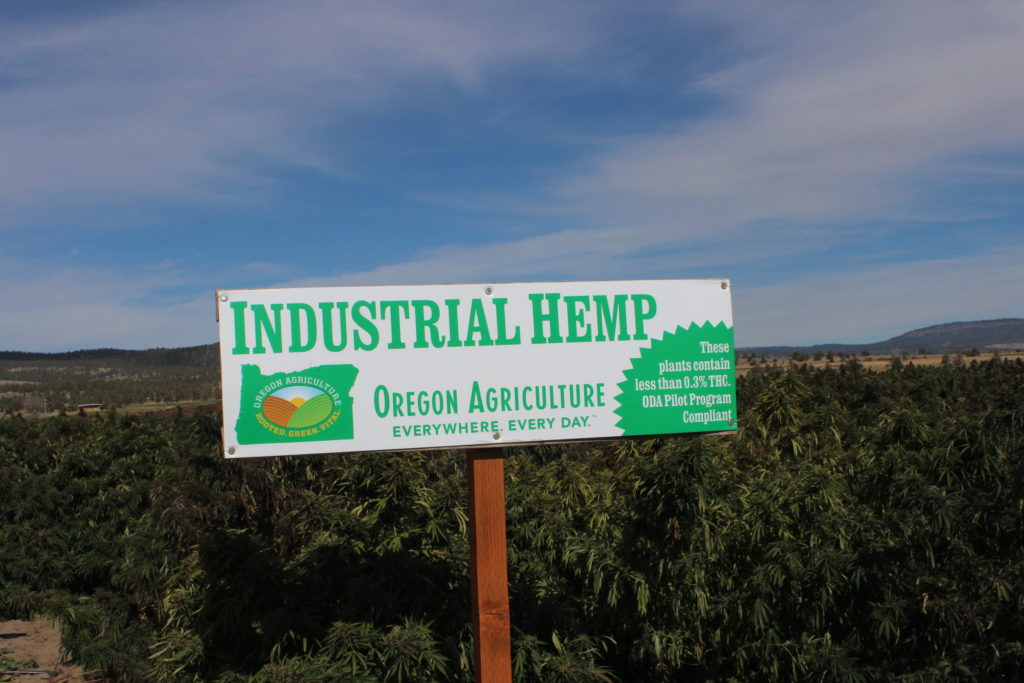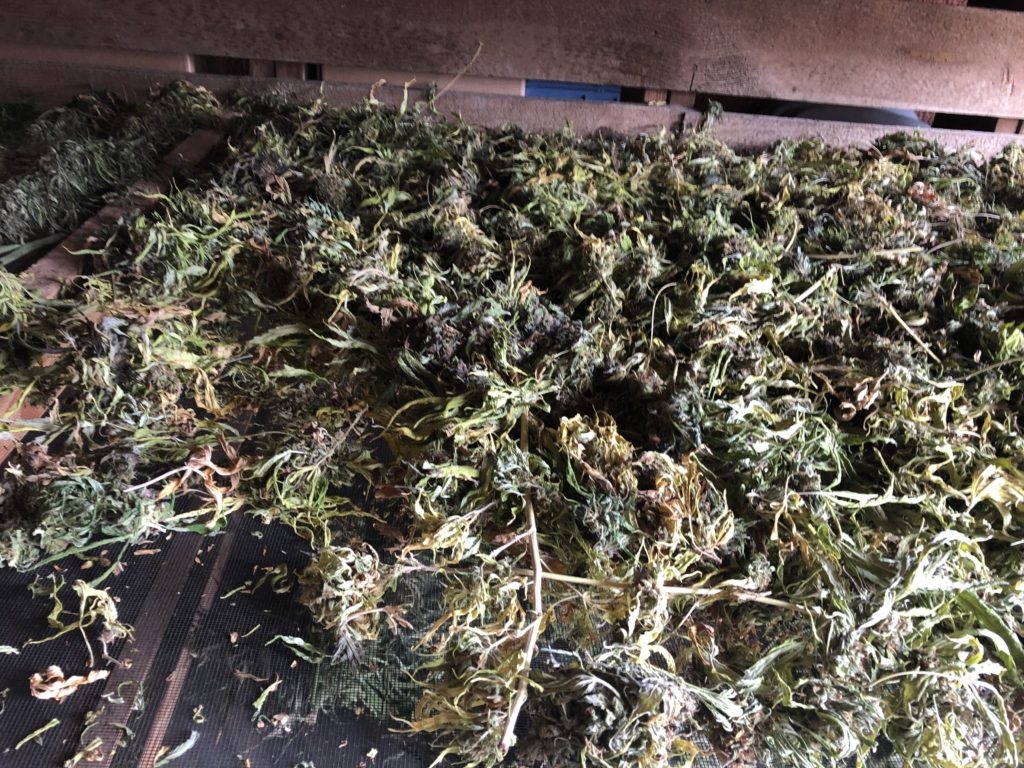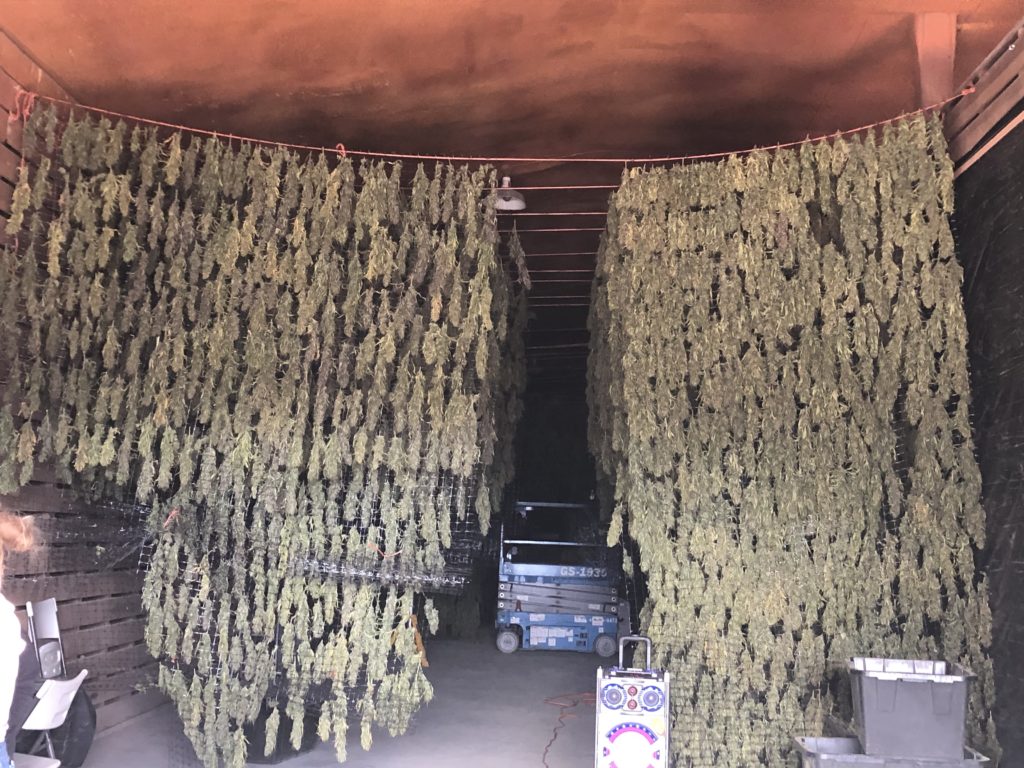Marc Staunton, one of the owners of MBS Farms in Malin, Oregon, spoke at the Klamath Water Users Fall Harvest Tour. Staunton said, he and his partners aren’t experts on growing industrial hemp, and no one is, because it is such a new crop.
“This is very young, budding, no pun intended, industry that is moving in the direction of modern agriculture and industrial agriculture, and we’ll say regulated agriculture,” Staunton said.
There are currently 55,000 registered acres in Oregon, Staunton said, with Jackson County having the largest acreage at 13,000 and Klamath County at about 3,000 registered acres.
After passage of the farm bill in November 2018, it became legal to grow industrial hemp nationwide.
Some states were more prepared to take on the task of regulating industrial hemp than others, Staunton said.
“The State of Oregon and Klamath County were prepared and allowed industrial hemp in their counties,” Staunton said.
Some of the benefits of CBD include:
• Anxiety and stress relief
• Energy
• Pain relief
• Neurological treatments
“Hemp can’t be patented like the pharmaceutical drugs and controlled by a group of people,” according to Dane Marshall, a partner in MBS Farms, and what that means is, it can be farmed by everyone.
Industrial hemp production also promotes the local economy. Hardware stores have seen a surge in sales from scissors to rubber gloves, Dane said.
Industrial hemp was a diversification for the farm, but it’s also a money crop, Dane continued.
Staunton said that a hemp plant, generally speaking, is a very good plant for soil. “It’s a diverse root mass that kind of seeks out different nutrients that could be very beneficial in our crop rotations.”
“What we’re hoping for is another cash crop for this basin, another crop that we don’t have to rely as heavily on volume of acreage to produce the same dollars, or better dollars,” Staunton said.
“If we can support our community, and by community we mean the people that we’re employing, the restaurants that are feeding those people, the hardware stores like Dane mentioned, the irrigation stores, the fertilizer companies—if we can do that, and we’re doing that by less acres, then there’s a definite appeal,” Staunton said.

Licensing, Banking and Insurance
Oregon Department of Agriculture (ODA) is licensing industrial hemp, according to Lela Marshall, also a partner in MBS Farms.
The process is: pay a $1,300 fee, provide ODA with information about the entity and actually map out the field or greenhouse.
“They want to know exactly where you are, how much you’re growing and what your plan is, and then with that you have to be under .03 percent THC, and they take that very seriously,” Lela said, adding testing must be done through ODA labs.
Besides the ODA testing preharvest, MBS Farms has also done their own testing to ensure they weren’t above .03 percent because if the crop tests too high in THC, it has to be destroyed.
Banking remains an issue for hemp growers. Currently, there are very few banks that will accept money from hemp growers.
Because hemp looks like marijuana, smells like it, sometimes even tastes like it, it makes it really difficult to regulate because it closely parallels a drug, Lela said.
Banks, along with everyone else are trying to figure out how to distinguish that line, Lela said.
The problem is, even though it’s legal to grow industrial hemp, there hasn’t been any federal legislation on the regulatory side of banking. This means a lot of banks are taking the approach that they won’t accept any money being used to support cash coming from a crop that could result in a fine, Lela said.
“There’s really only one (bank) that I’ve heard of, and they have a three month wait list. So it’s pretty complicated when you get to that point, but hopefully next year, for the next growing season, we’ll be able to bank properly,” Lela said.
Secure and Fair Enforcement (SAFE) Banking Act, is currently in congress and passage of this bill would allow banks lending or receiving money into their depository accounts from production of industrial hemp or marijuana from legal repercussions.
Next year there will be multi-crop insurance for hemp, but this type of insurance is based on crop history when making a claim, which is problematic with a new crop, since there is no crop history.
Liability insurance is another issue with industrial hemp, Staunton said.
“Insurance companies are very conservative and would like to steer away from anything related to industrial hemp until they see more consistent regulation, so that’s another problem,” Staunton said.
Planting
MBS Farms has roughly 50 acres planted of organic hemp. MBS Farms planted their hemp about the 21st of May and planting went into the first week of June. There are about 2,000 plants to the acre and a six-foot spacing between the plants.
“Most of the field here was done by transplanting. So transplanting is probably the most common approach right now,” Staunton said.
The seed is planted in the greenhouse and grows there for about 30 days, then it’s transferred to the field and planted using a spade planter—a very slow time-consuming process, Staunton said.
The benefits to transplanting are it is accurate, the plant is set in the ground, it’s covered and there is full soil penetration to the rootstock, Staunton said.
Another method used for planting was direct seeding. Direct seeding has potential because it is faster and skips the greenhouse process that is very costly and time-consuming. The difficulty right now is most seed is extremely expensive, Staunton said.
Grain drills have also been used, but they are very uncontrolled and spacing can be inaccurate compared to transplanting, Staunton said.
Growers need to get the most bang for their buck, and currently transplanting is the safest, but it’s the first year, and Staunton thinks next year there could be changes in planting.
Seed
Different companies are trying to develop genetics which is basically how the plant grows, and how it produces by crossing different strains, Staunton said.
“That’s how they’re producing their genetics, and you’ll get to this point where the seesaw effect will weed out the highest, best producing,” Staunton said.
Someone in the audience said Oregon CBD went online and sold 11 million seeds, at a dollar a seed, in nine minutes.
Oregon CBD had a couple of genetic strains they developed early on—four to five years ago—and they were able to ramp up inventory and meet supply better than anybody else, Staunton said.
“They had supply as this thing was taking off, which was really unique,” Staunton said.
Irrigation
MBS Farms used drip tape for irrigation. Drip tape isn’t used in the Klamath Basin because they don’t the have the high value crops like the Central Valley of California. This has made it difficult to justify using it in the past, Staunton said.
Drip tape is very expensive compared to overhead or wheel line irrigation that can irrigate larger areas at one time, but it’s not as accurate or as efficient in water use as drip, Staunton said.
“I was excited to try it because now we potentially had a crop that could justify that value,” Staunton said, and he was impressed with it, particularly the accuracy.
With drip irrigation, it is right next to the root zone, no more, no less, Staunton said, and it retained the moisture on the berm under the plastic.
With overhead irrigation there would be evaporation, but with drip tape Staunton didn’t have that evaporation, so they were irrigating less, and in turn, using less water.
Staunton is excited that there could be opportunities in other Basin crops for drip irrigation.




There were challenges to drip irrigation. Poor water quality in the Basin requires an expensive filtration system, Staunton said, but compared to other crops grown here, hemp uses much less water.
Harvesting
A full spectrum of harvesting is being attempted on hemp, Staunton said. “We have guys still out here hand clipping the tops (we call it top flower), and they’re doing that by hand.”
MBS Farms also has workers walking through the field picking the biggest flowers, clipping them off, transporting them to the shed, and hanging them to dry.
There are local hemp growers who have mechanized this process somewhat, Staunton said, but the most common way is still to hand clip the flower.
Flowers could be clipped all day every day, and never remove all the flowers from the plant, so the next step is harvesting the entire plant to extract as much of the oil as possible, Staunton said.
Several approaches have been attempted that include:
• Chainsaws
• Machetes
• Mechanized—sickle bars used in other crops like alfalfa, mounted saw blades and silage choppers that grind the whole plant
Staunton said, John Deere is also advertising a hemp cutter.
Staunton sees the future of harvest with a combine, and in the future, the field could look totally different than it does currently.
“I’m very positive that down the road this process will look a lot different because our focus of being just all oil will be a lot different,” Staunton said.
Hemp Uses
“Everyone that is growing industrial hemp in this area (Klamath County) is growing it for the oil,” Staunton said.
There are other uses for industrial hemp, but there aren’t outlets currently available for it in the Klamath Basin.
The highest content for oil is in the top of the flowers. “When you’re trying to look at harvesting that plant everyone is trying to figure out how to take that mass of green and get the most content of oil you can while still making harvest somewhat easy,” Staunton said.
Past approaches have been to remove the whole plant, hang it, dry it down, then strip off the leaves and sell them to an oil extractor, Staunton said.
Most growers are searching for ways to remove the leaves in the field and dry it down in the field, or by some other drying process to have a marketable product in biomass that would be sold to an extractor.
There are numerous uses for industrial hemp besides oil, Staunton said. The industry has been limited to an extent in developing other uses because they need a reliable supply of product, but he sees that coming.
People in the audience mentioned that Nike is growing hemp to make shoes and a company in Kentucky is using hemp to make flooring.
Learning Curve
Part of the learning curve this year for Staunton is the size of the plants. Large plants may not be the best idea when it comes to harvest, so tighter spacing is being considered in the future to limit growth and make the plant more manageable at harvest.
Variety is another consideration and each variety has a very different character trait. One might be really tall, and the next short and wide.




Hand Drying
Hand drying entails hanging the flowers clipped from the field for a minimum of three days in good drying the weather, to extended periods of time—so long as they are in a stable environment, Staunton said.
Moisture content needs to be monitored constantly through the entire process, starting from the field to the point they are placed in containers and sent to the processor, Staunton said.
Freedom to Farm
Industrial hemp does have a distinctive odor. “Other than smell and pollen, there is probably very little risk to this crop versus other crops grown,” Staunton said.
According to ODA, “Legislation adopted in 1993 and updated in 1995 and 2001, declares farm and forest practices as critical to the welfare of the Oregon economy, and establishes a right to farm law. This law protects growers from court decisions based on customary noises, smells, dust, or other nuisances associated with farming. It also limits local governments, and special districts from administratively declaring certain farm and forest products to be nuisances or trespasses (ORS 30.930).”
Is There Money to be Made on Hemp?
Staunton said, there are those that view industrial hemp as a really big bubble that will eventually crash.
“I think there’s some definite potential that that could happen. Like I mentioned, there’s 55,000 (registered) acres planted in the State of Oregon. The year before, I believe, there was less than 8,000 registered (acres), so that’s a huge increase in acres,” Staunton said.
The development of other markets is an unknown. There could be a shift toward more textile based product and less oil. CBD based products could eliminate opioids in hospitals for pain management, Staunton said.
“Those things are all unknown,” Staunton said, but he isn’t ready to say that industrial hemp will be a one and done.